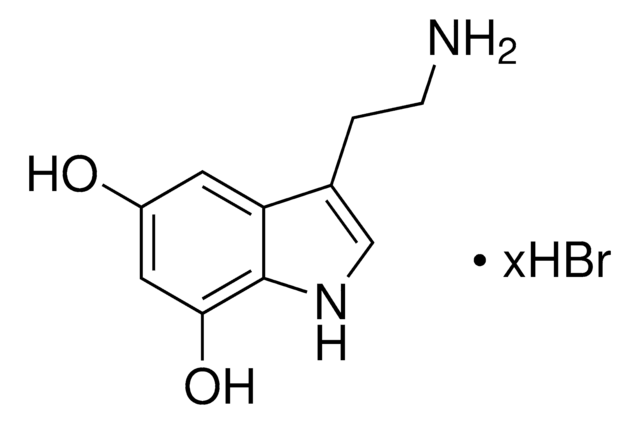H4381
6-Hydroxydopamine hydrochloride
≥97% (titration), powder, neurotoxin
Sinónimos:
2,4,5-Trihydroxyphenethylamine hydrochloride, 2,5-Dihydroxytyramine hydrochloride, 2-(2,4,5-Trihydroxyphenyl)ethylamine hydrochloride, 6-OHDA
About This Item
Productos recomendados
product name
6-Hydroxydopamine hydrochloride, ≥97% (titration), powder
Análisis
≥97% (titration)
formulario
powder
color
off-white to brown
mp
232-233 °C (dec.) (lit.)
solubilidad
H2O: >50 mg/mL, clear, yellow to brown
temp. de almacenamiento
room temp
cadena SMILES
Cl.NCCc1cc(O)c(O)cc1O
InChI
1S/C8H11NO3.ClH/c9-2-1-5-3-7(11)8(12)4-6(5)10;/h3-4,10-12H,1-2,9H2;1H
Clave InChI
QLMRJHFAGVFUAC-UHFFFAOYSA-N
¿Está buscando productos similares? Visita Guía de comparación de productos
Descripción general
Aplicación
- to induce Parkinson′s disease (PD) in rats
- to analyse cytotoxic effect of 6-OHDA on PC12 cell line
- to induce noradrenergic (NA) neuron deletion from the locus-coeruleus
Acciones bioquímicas o fisiológicas
Precaución
Reconstitución
Palabra de señalización
Warning
Frases de peligro
Consejos de prudencia
Clasificaciones de peligro
Eye Irrit. 2 - Skin Irrit. 2 - STOT SE 3
Órganos de actuación
Respiratory system
Código de clase de almacenamiento
11 - Combustible Solids
Clase de riesgo para el agua (WGK)
WGK 3
Equipo de protección personal
dust mask type N95 (US), Eyeshields, Gloves
Certificados de análisis (COA)
Busque Certificados de análisis (COA) introduciendo el número de lote del producto. Los números de lote se encuentran en la etiqueta del producto después de las palabras «Lot» o «Batch»
¿Ya tiene este producto?
Encuentre la documentación para los productos que ha comprado recientemente en la Biblioteca de documentos.
Los clientes también vieron
Nuestro equipo de científicos tiene experiencia en todas las áreas de investigación: Ciencias de la vida, Ciencia de los materiales, Síntesis química, Cromatografía, Analítica y muchas otras.
Póngase en contacto con el Servicio técnico











